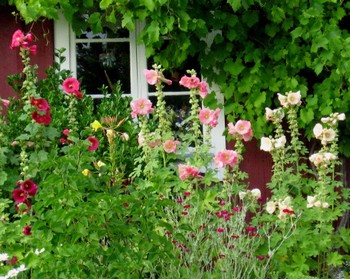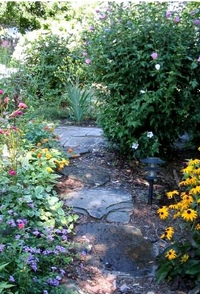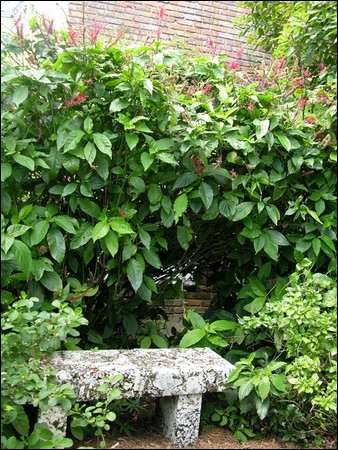An English country garden is fun and easy to design if you have the right elements. Learn how to design a true English cottage garden from our tips, ideas and advice using the right cottage flowers and cottage garden plants for an effective cottage garden design.
IDEAS FOR CREATING AN ENGLISH COUNTRY GARDEN
When we talk about a cottage garden we are really talking about an English country garden. The plants and flowers that are used in such a garden design, are seen in gardens throughout England. These country gardens conjure up thoughts of romance, bumble bees, butterflies and lazy summer days.
To try and recreate such a garden is not difficult, but to be successful you should choose your cottage plants and flowers wisely with regards to color groupings, know the heights of your plants so that you have proper planning, and finally choosing cottage plants that will thrive in your climate and soil conditions.
So, where exactly does one begin, and what elements are needed to create English country gardens?
DESIGNING AN ENGLISH COUNTRY GARDEN

Typically is surrounds a small, simple house with a porch. And being so confined, the cottage style has no room no need for lawn. Instead, pathways cut a swathe through the cottage garden plants and flowers, usually made of brick, shell, gravel or aggregate.
Where cottage gardens appear haphazard and abundant, success requires careful placement and knowledge of height and spread of your cottage garden plants. Climbing roses and wisteria give both height and romance to these gardens, especially when they provide a backdrop to other summer cottage flowers such as poppies, cornflowers, Delphiniums, lavender and Erigeron daisies. Of course don't forget that we can't just think of summer. What about Spring Bulbs for your cottage garden?
The cottage garden, or English country garden, is best for those who love to garden, for the style is not low-maintenance. It looks informal, as if nature had scattered its seed to paint the various tapestries of color, but in actual fact, it is highly contrived. Making sure that you have a garden that blooms constantly, is no mean feat.
Design Elements for an English Country Garden
 Choose simple cottage flowers for your cottage garden design and make sure that they are old-fashioned varieties. Try and choose a color scheme like pinks and whites, or blues and yellows. Where you choose to have a whole spectrum of colors then make sure that the palette is soft.
Choose simple cottage flowers for your cottage garden design and make sure that they are old-fashioned varieties. Try and choose a color scheme like pinks and whites, or blues and yellows. Where you choose to have a whole spectrum of colors then make sure that the palette is soft.Warm brick paths, rambling roses and other climbers, pastel perennials and self-sowing annuals such as allysum are characteristic of a cottage style garden.
Choose fragrant flowers for both garden, arbors and houses.
Let your garden show your personality. Choose your plants for personal preference and meaning rather than for design.
Plant flowers and plants in small pockets rather than in large drifts.
ENGLISH COUNTRY GARDEN DESIGNS IN HARMONY WITH YOUR HOUSE
Don't just think of your garden, but also think of your house. Ideally, your house should be covered in some flowering climber to link your house to your garden. Wisteria, honeysuckle, golden shower, star jasmine, clematis, ornamental grapes or even climbing roses such as the lovely "Albertine", will do the trick.
If you have ugly steps that lead to your house, tile them with terracotta tiles, and then soften the edges by placing lavender, geraniums and other colorful plants in pots and line the steps with these.

English Country Garden Design Tips
Traditionally the cottage garden is surrounded by either a fence, wall or hedge with a gate giving access to the property. There is usually a pathway, that is seldom straight in nature, that leads from the gate to the front of the house. While the garden beds on either side of the pathway need not be mirror-images of one another, they should be equally balanced in the choice of colors used either side, and the cottage plants used in both garden beds should be similar in height and type so that there is a definite pattern that is evident.
Stay away from colorful hybrids and go for the traditional cottage garden flowers that give you soft colors and small flowers.
Don't just concentrate on the flowers. Include garden features such as bird baths, bird houses, benches, bird feeding tables where you can feed the wild birds, chairs, containers and window boxes. You can also have some fun with wheelbarrows, old milk churns and other old farming equipment.
Because most of your cottage plants are herbaceous they will die down in winter. Therefore you need to add some plants that will be evergreen or flower during that time to give your garden a winter interest. Plants such as rosemary, germander, lavender and boxwood will help out here. Cool weather annuals such as pansies can also be planted for color, as well as ornamental kales.
Make your country garden serviceable. Plant espaliered fruit trees such as pear trees and fruiting shrubs such as black and red currants and blueberries close to the perimeter of the house. Intersperse your flowers with medicinal herbs for easy picking when needed.
Steps to Creating an English Country Garden
1. Choose Feature, Filler and Anchor Plants
You need feature plants that will create interest to your garden. Roses are the ideal feature plant. Hydrangeas could be considered filler plants including others such as hollyhocks, lavender and viburnum. Your anchor plants are those that create a backdrop to your canvass and are placed at the back of the beds due to their height. These are usually evergreens and could be conifers, boxwood and other small trees.2. Create Different Areas
Create different areas of your garden so that you don't view the whole of your garden at once. Instead you create different areas for added interest. The sizes of these areas will be in direct proportion to the size of the garden as a whole.3. Grow Living Dividers
In order to divide each area from the other you need to plant hedges of some sort to form a division. A flowering plant like wegiela, boxwood, or any tall growing evergreen hedging should be planted to create living dividers. These should be encouraged to grow 6-8 feet high to create this effect.4. Build a Fence
Fences, particularly picket fences, should be built to allow your space to be defined and to protect your garden. If built correctly, it will add to help creating the typical English country garden that you are making.
5. Add an Arbor
Arbors can help lead your visitors to your house, from the gate and up the path. If covered in climbing roses one evokes an element of romance. Arbors also define that feeling of entering a space.6. Build a Gate
Gates not only keep out unwanted visitor, be that either the two-legged or the four-legged variety, but depending on what you choose will help create your cottage style. Many of you will opt for the white-washed gate to go with the white-washed picket fence. However, it doesn't have to be just white. You could have a plain or painted iron fence, an unpainted wooden fence, or even a wrought-iron fence. It really remains up to the individual, and your choice of gate will further help to show your personality.7. Plant your Pathways
Whether you choose a straight path or a curved path, this pathway should lead your visitors to your home from your gate. The pathway can be constructed from reclaimed stone or brick to shells or pebbles. It can be made from just about any material other than concrete. By allowing the plants to grow onto the pathway you are softening the edges and are one step closer to creating a wonderful English country garden.To read more, like about achieving year-round colour in your garden, follow this link:
http://www.countryfarm-lifestyles.com/cottage-garden.html
No comments:
Post a Comment